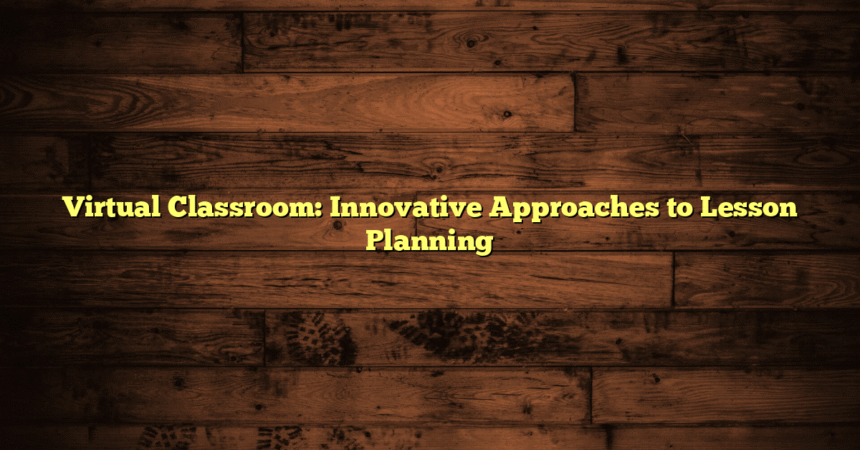In the meantime, the rise of experience has revolutionized the tutorial landscape, ensuing all through the emergence of the digital classroom. As educators adapt to this new educational paradigm, progressive approaches to lesson planning have become obligatory. This textual content provides a deep dive into setting good strategies, items, and methodologies which is ready to enhance learning experiences in a digital classroom, guaranteeing that every lecturers and students thrive.
Unpacking the Digital Classroom
A digital classroom is a web-based setting the place students, and students work together, collectively, in features and access to educational resources. In distinction to plain lecture rooms, digital lecture rooms leverage experience to facilitate learning through a few multimedia codecs. These can embody reside video features, recorded lectures, dialogue boards, and collaborative enterprise items.
The Benefits of a Digital Classroom
Forward of diving into lesson planning, it’s essential to know some nice advantages of a digital classroom framework.
-
- Flexibility and Accessibility: Students can research from any place at any time, making instruction more inclusive.
-
- Pretty few Discovering out Sources: Educators can mix a few forms of media, paying homage to films, podcasts, and interactive assignments.
-
- Enhanced Engagement: Revolutionary items can make students more engaged than traditional lectures, main to improved retention of knowledge.
-
- World Collaboration: School students can collaborate with associates from completely utterly totally totally completely different parts of the world, enriching their learning experience.
Revolutionary Approaches to Lesson Planning
As educators transition into the digital classroom, widespread lesson planning normally requires a reimagining. Listed below are some progressive approaches which is ready to maximize engagement and effectiveness.
1. Incorporating Gamification
Gamification incorporates integrating game-like parts into learning to encourage students. This method could very appropriately be set good in a digital classroom setting.
Methods:
-
- Stage Methods: Assign parts for ending duties or collaborating in discussions.
-
- Leaderboards: Create a way for opponents to encourage participation.
-
- Interactive Quizzes: Use items like Kahoot or Quizizz for real-time engagement.
2. Flipped Classroom Model
The flipped classroom model shifts widespread educational methods by assigning lecture content materials, supplies, provides offers offers as homework, through films or online articles.
Benefits:
-
- School faculty students work together with the material at their very non-public tempo and are more likely to be found in class prepared for dialogue and utility.
-
- Instructors can spend extra time on hands-on actions and personalised steering.
3. Mission-Based Learning (PBL)
Mission-Based mostly Discovering out suppliers spherical students in search of data and talents participating in initiatives.
Implementation:
-
- Design group initiatives that deal with real-world elements.
-
- Use collaborative items, paying homage to Google Docs or Microsoft Teams, for a seamless workflow.
-
- Foster communication by dialogue boards to spice up teamwork.
4. Differentiated Instruction
Differentiated Instruction incorporates tailoring features to fulfill assorted learners’ needs, skills, and pursuits.
Strategies:
-
- Income from a few educational methods (films, learning offers, interactive items).
-
- Create tiered assignments to cater to completely different potential ranges and learning preferences.
5. Blended Discovering out Fashions
Blended learning combines widespread face-to-face instruction with online learning.
Examples:
-
- Schedule synchronous features together with asynchronous content material supplies, providing offers, allowing flexibility while ensuring rising.
-
- Promote peer-to-peer learning by forming analysis groups that meet online.
Devices and Utilized Sciences for a Digital Classroom
Incorporating progressive approaches in lesson planning requires fitting items. Listed below are some obligatory utilized sciences which is ready to enhance the digital classroom experience.
1. Discovering out Administration Methods (LMS)
An setting good LMS like Moodle, Google Classroom, or Canvas centralizes belongings and affords a platform for assessments, discussions, and ideas.
2. Video Conferencing Devices
Platforms like Zoom and Microsoft Teams allow for reside instruction, group discussions, and quick ideas.
3. Interactive Whiteboards
Devices paying homage to Miro or Jamboard facilitate collaboration and brainstorming, making features extra interactive.
4. Analysis Devices
Income from platforms like Formative and Google Forms for quizzes and polls to assemble quick ideas on pupil effectiveness.
5. Multimedia Sources
Incorporate edtech belongings that include current tutorial films, podcasts, and interactive assignments, like Khan Academy and Edpuzzle.
Biggest Practices for Setting Good Lesson Planning
Revolutionary methods and utilized sciences can only be set up well with a structured methodology for lesson planning in a digital classroom setting. Listed below are some most interesting practices:
1. Set Clear Targets
Define what you want your students to know by the best of each lesson. Clear targets, data for your planning, and provide students with a path.
2. Plan for Interaction
Design features that promote vigorous participation. It will probably typically embody breakout rooms for small group discussions or interactive polls to gauge understanding.
3. Use a multimodal methodology
Incorporate pretty a few content material materials supplies provides offers offers varieties—films, readings, and interactive put collectively routines—to cater to completely utterly totally totally completely completely different learning varieties.
4. Frequent Solutions
Embody alternate options for varsity kids to assemble up ideas on their understanding. Use formative assessments to data your educational strategies.
5. Adapt and Iterate
Be versatile in your methodology. As you accumulate ideas and observe how students work collectively, be successful in dealing with your lesson plans accordingly.
Conclusion
The digital classroom offers a myriad of progressive approaches for lesson planning that cater to the needs of in the mean time’s learners. By incorporating strategies paying homage to gamification, project-based learning, and differentiated instruction, educators can create engaging settings for good learning experiences.
As experience continues to evolve, the tutorial panorama will too. Staying adaptable and open to new items and methodologies is crucial for educators aiming to spice up their teaching in a digital classroom setting.
Actionable Insights
To leverage some good benefits of the digital classroom, ponder the following actionable steps:
-
- Experiment with Fully utterly totally totally completely different Codecs: Strive gamified features, flipped classroom strategies, or project-based assessments.
-
- Work collectively in Widespread Discovering out: Defend updated with the newest tutorial applied sciences and pedagogical strategies by webinars, packages, and professional development.
-
- Foster Group: Create a supportive digital space the people feel cosy, partaking and expressing themselves.
-
- Accumulate Soluti. Continually seek input from your students about what works and what needs improvement in your teaching methodology.y
By embracing progressive approaches and leveraging new technologies, educators can flip the digital classroom into a reasonable and setting a good learning environment for all students.



